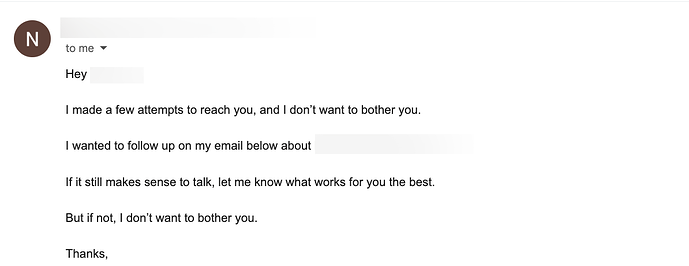Hi everyone!  I’ve been working on improving my follow-up email game, especially when sending polite reminders after receiving no response.
I’ve been working on improving my follow-up email game, especially when sending polite reminders after receiving no response.
I would love to hear your thoughts, experiences, and any tips you might have in navigating the art of follow-up emails.
1 Like
Hi there!
Navigating follow-up emails can be a bit tricky, but I totally get where you’re coming from.
Here are some tips for writing a professional follow-up email without overwhelming the recipient:
-
Friendly Opener: Include a friendly opener that is free from cliches. Start your follow-up email with a sincere tone.
-
Acknowledge Their Time: Mention your previous email and express you understand their busy schedule. You wouldn’t want to blame the person for not responding to you; keep the tone friendly and understanding.
- Clear and Concise Message: Keep your follow-up brief and to the point. Highlight the key points from your initial email.
-
Offer Additional Information: Provide any necessary details or additional information that might address their questions or concerns.
-
Polite Closing: Express gratitude and maintain a positive tone. Mention that you wait for their response without getting spammy and disturbing.
-
Follow-up Timing: Space out your follow-ups appropriately; consider waiting at least a week before sending a second follow-up. Constantly sending follow-up emails is not the right solution if you want to avoid overwhelming them.
The best way to follow up on an email is to be respectful, understanding and focused on providing value. I hope these tips help! 
Let me know if you have any more questions.
2 Likes
Hi, everyone.
Navigating follow-up emails requires finesse to ensure effectiveness without being overwhelming and persistent.
Here is what a follow-up email shouldn’t look like:
- Overly persistent: Avoid bombarding the recipient with multiple follow-ups in a short span. It may come across as pushy.
- Impersonal or generic: Steer clear of generic follow-up templates. Tailor your message to show genuine interest in the individual and the subject matter.
- Lack of patience: Resist the urge to follow up too quickly. Give the recipient ample time to respond, considering their workload and priorities.
I’m sure you wouldn’t want to respond to a follow-up email with these qualities. You might also wonder how to avoid them.
You can follow these steps to avoid these pitfalls:
- Personalize your follow-up. Reference specific details from your initial email to demonstrate your attention to their needs.
- Be clear and avoid lengthy follow-ups. Keep your message concise, focusing on the essentials to make it easy for the recipient to understand and respond.
- Maintain a friendly, polite, and respectful tone. Avoid sounding frustrated or impatient, even if you’re eager for a response.
- Ensure your follow-up adds value. Offer additional information or insights that might address potential concerns or questions.
Keep in mind that a well-crafted follow-up should be considerate, clear, and add value without being a source of annoyance. Hope it helps!
Hello, guys!
These tips are really helpful! I also came across a great example of a follow-up email that struck the perfect balance of professionalism and courtesy, which is this one:
Here are what makes this effective, in my opinion:
- Politeness: The email maintains a consistently polite and respectful tone throughout.
- Clarity: The message is clear, concise, and to the point, making it easy for the recipient to understand the purpose of the follow-up.
- Providing options: Offering additional information and options shows a willingness to be accommodating and understanding.
Feel free to share your thoughts on this example or provide your own insights! Let’s learn from each other’s experiences. 
I usually keep my follow-ups really simple and human. What works best for me is avoiding long reminders and instead sending something short that makes it easy for the other person to reply.
A couple things that help:
- Wait a reasonable amount of time (usually 2–4 days) so it doesn’t feel pushy.
- Keep it light, something like “just wanted to circle back in case this slipped through” works better than a long recap.
- Give them an easy yes/no or one quick action. People respond faster when there’s low effort.
- Remove pressure. Sometimes I’ll add “no rush if you’re busy” and it actually increases replies.
- Change the angle slightly. Instead of repeating the same message, I clarify the value or ask a single, specific question they can answer quickly.
Most of the time people just missed the first email, so a friendly nudge is usually enough. 
![]() I’ve been working on improving my follow-up email game, especially when sending polite reminders after receiving no response.
I’ve been working on improving my follow-up email game, especially when sending polite reminders after receiving no response.

